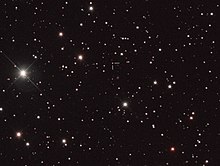A0620-00
| Observation data Epoch J2000 Equinox J2000 | |
|---|---|
| Constellation | Monoceros |
| Right ascension | 06h 22m 44.542s[1] |
| Declination | −00° 20′ 44.29″[1] |
| Apparent magnitude (V) | 11.2[2] |
| Characteristics | |
| Evolutionary stage | Black hole + main sequence[3] |
| Spectral type | K5 V[3] |
| Variable type | X-ray nova, Ellipsoidal[4] |
| Astrometry | |
| Radial velocity (Rv) | −5±12[5] km/s |
| Proper motion (μ) | RA: −0.439[1] mas/yr Dec.: −5.138[1] mas/yr |
| Parallax (π) | 0.6969 ± 0.1168[1] mas |
| Distance | approx. 4,700 ly (approx. 1,400 pc) |
| Orbit | |
| Period (P) | 7.75234 ± 0.00010[5] hr |
| Inclination (i) | 50.98 ± 0.87[3]° |
| Periastron epoch (T) | JD 2446082.7481 ± 0.0008[5] |
| Semi-amplitude (K1) (primary) | 457 ± 8[5] km/s |
| Details[3] | |
| Black hole | |
| Mass | 6.61 ± 0.25 M☉ |
| K-type star | |
| Mass | 0.40 ± 0.045 M☉ |
| Other designations | |
| Database references | |
| SIMBAD | data |
A0620-00 (abbreviated from 1A 0620-00) is a binary star system in the constellation of Monoceros.
A0620-00 consists of two objects. The first object is a K-type main-sequence star with a spectral type of K5 V.[3] The second object cannot be seen, but based on its calculated mass of 6.6 M☉,[3] it is too massive to be a neutron star and must therefore be a stellar-mass black hole.[5] At a distance of about roughly 3,300 light-years (1,000 parsecs) away, this would make A0620-00 one of the nearest known black holes to the Solar System, closer than GRO J1655-40.[6] The two objects orbit each other every 7.75 hours.[5]
A0620-00 has undergone two X-ray outbreaks. The first one was in 1917.[7] The second burst, in 1975, was detected by the Ariel 5 satellite.[8] During that time, A0620-00 was the brightest X-ray point source.[5] It is now classified as an X-ray nova.[5] Its black hole nature was determined in 1986.[5]

The black hole in A0620-00 pulls matter from the K-type star into an accretion disk.[3] The accretion disk emits significant amounts of visible light and X-rays. Because the K-type star has been pulled into an ellipsoidal shape, the amount of surface area visible, and thus the apparent brightness, changes from the Earth's perspective. A0620-00 also bears the variable star designation V616 Monocerotis.[4]
Stephen Hawking memorial broadcast[]
On 15 June 2018, a signal was transmitted from the European Space Agency big radio antenna at Cebreros Station (77 kilometers west of Madrid, Spain), in memory of Stephen Hawking, who died on 14 March 2018, and his work on the physics of black holes. The broadcast will travel the 3,457-light-year distance at the speed of light and will arrive in the year 5475; this will be the first-ever human interaction with a currently known black hole.[9] 1A 0620-00 was chosen for this broadcast as it was the closest known black hole to Earth at the time.[10] The message was one of peace and hope according to his family.
References[]
- ^ a b c d Brown, A. G. A.; et al. (Gaia collaboration) (2021). "Gaia Early Data Release 3: Summary of the contents and survey properties". Astronomy & Astrophysics. 649: A1. arXiv:2012.01533. Bibcode:2021A&A...649A...1G. doi:10.1051/0004-6361/202039657. S2CID 227254300. Gaia EDR3 record for this source at VizieR.
- ^ a b "1A 0620-00". SIMBAD. Centre de données astronomiques de Strasbourg. Retrieved 26 August 2017.
- ^ a b c d e f g Cantrell, Andrew G.; Bailyn, Charles D.; Orosz, Jerome A.; McClintock, Jeffrey E.; Remillard, Ronald A.; Froning, Cynthia S.; Neilsen, Joseph; Gelino, Dawn M.; Gou, Lijun (2010). "The Inclination of the Soft X-Ray Transient A0620-00 and the Mass of its Black Hole". The Astrophysical Journal. 710 (2): 1127–1141. arXiv:1001.0261. Bibcode:2010ApJ...710.1127C. doi:10.1088/0004-637X/710/2/1127. S2CID 33906909.
- ^ a b Samus, N. N.; Durlevich, O. V.; et al. (2009). "VizieR Online Data Catalog: General Catalogue of Variable Stars (Samus+ 2007-2013)". VizieR On-line Data Catalog: B/GCVS. Originally Published in: 2009yCat....102025S. 1. Bibcode:2009yCat....1.2025S.
- ^ a b c d e f g h i McClintock, J. E.; Remillard, R. A. (1986). "The black hole binary A0620-00". Astrophysical Journal. 308: 110–122. Bibcode:1986ApJ...308..110M. doi:10.1086/164482.
- ^ Foellmi, Cédric (2009). "What is the closest black hole to the Sun?". New Astronomy. 14 (8): 674–691. arXiv:0812.4232. Bibcode:2009NewA...14..674F. doi:10.1016/j.newast.2009.04.003. S2CID 12843219.
- ^ Eachus, L. J.; Wright, E. L.; Liller, W. (1976). "Optical observations of the recurrent nova associated with A0620-00 - 1917-1975". Astrophysical Journal. 2. 203: L17–L19. Bibcode:1976ApJ...203L..17E. doi:10.1086/182009.
- ^ Elvis, M.; Page, C. G.; Pounds, K. A.; Ricketts, M. J.; Turner, M. J. L. (1975). "Discovery of powerful transient X-ray source A0620-00 with Ariel V Sky Survey Experiment". Nature. 257 (5528): 656–657. Bibcode:1975Natur.257..656E. doi:10.1038/257656a0. S2CID 4160399.
- ^ Ghosh, Pallab (15 June 2018). "Prof Hawking: A fitting way to go". BBC. Retrieved 20 July 2019.
- ^ Kelly, Guy; Davies, Gareth (15 June 2018). "Stephen Hawking laid to rest between graves of Sir Isaac Newton and Charles Darwin". The Telegraph. ISSN 0307-1235. Retrieved 16 June 2018.
External links[]
- "A0620-00". Black Hole Encyclopedia. StarDate. 12 February 2012. Archived from the original on 1 April 2012. Retrieved 24 April 2017.
- X-ray binaries
- Stellar black holes
- K-type main-sequence stars
- Monoceros (constellation)
- Objects with variable star designations